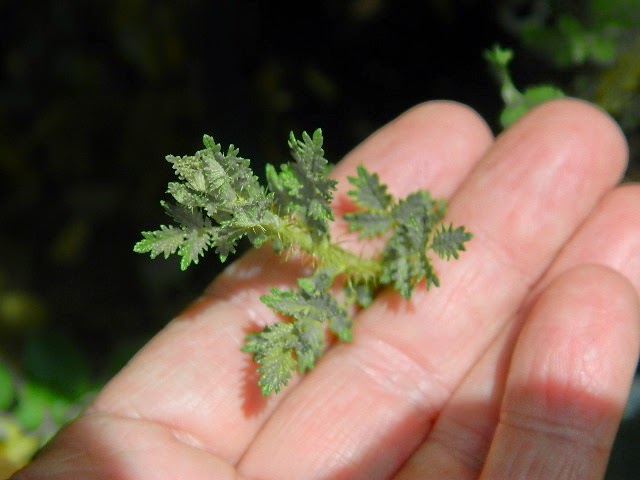After a cane has flowered, it bends over to touch the ground, much like a peanut plant. Once the tip contacts suitable soil, it roots, "hop scotching" across the ground.
Minutifolia is completely healthy in the two areas I've grown it. Reportedly, it dislikes summer water, however I've had great success growing it in the ground as well as five gallon nursery containers in standard potting soil, providing it with the same water levels and frequencies I've provided all the other roses. This rose goes summer dormant. The tiny foliage and bristles permit it to capture moisture from the fogs. When moisture becomes truly scarce, the foliage dries up and is shed, reducing the water needs of the plant until the rains or fogs return.
There are supposedly two, distinct forms of the species. The most commonly available is the San Diego form which has been propagated from the stand naturally occurring on Otay Mesa in San Diego County. It seldom sets seeds, appearing to be self sterile and possibly female sterile as well. It has refused every pollen I have ever placed on it. The other form is from the stand naturally occurring in Mexico. The Mexican form reportedly sets seed quite well.
I've worked with R. Minutifolia for far too many years to count by now. Seeds have been generated, a few have actually germinated, yet none have survived. I've most frequently used its pollen to pollinate blooms on miniatures and the more fertile floribundas I prefer to use as seed parents. This year, I've even attempted to pollinate R. Fedtschenkoana with Minutifolia's pollen.
Working with these tiny, prickly buds can be rather "frustrating". They're difficult to hold on to because they are so small to begin with. Add the bristles on the ovaries which make them incredibly slippery and you can imagine what it's like to collect pollen from a large quantity of them. Fortunately, or unfortunately, my four plants seldom provide "large" numbers of buds at one time.
Finding these tiny buds among the minute foliage can be quite difficult.
It isn't as difficult when they appear at the terminal ends of the canes as it is when they hide among the tiny leaves along the canes.
The batch of buds pictured above finally provided their harvest after more than half an hour of "micro surgery". After two days of air drying on a piece of paper, it was back out in the garden to spread their golden dust in this year's attempts at finally raising seedlings containing their genes. Wish me luck!











A very interesting plant. Would you know of any source that would ship to Florida ?
ReplyDeleteYou should probably contact Rancho Santa Ana to see if they are licensed to mail plants to Florida. They are listed in the "Buy From" tab on Help Me Find-Roses. Here is the address of their web site. Good luck!
Deletehttp://www.rsabg.org/component/content/article?catid=156:articles&id=542:grow-native-nursery
I look forward to receiving your posts. Each time I learn something new :-) I wish you all the good luck, a new hybrid with that dainty foliage would be lovely....
ReplyDeleteThank you! I am happy you find the posts enjoyable and I'm able to help introduce you to some things you may not have been aware of. Thanks for the good luck wishes, too!
DeleteI had no Idea there was a rose like this, so fascinating it sounds like it acts more like a desert dwelling Euphorbia rather than a rose with it's shedding of leaves whle going into dormancy during the heat . I am really enjoying the articles on the menagerie of roses you put on parade.
ReplyDeleteHi Bekah, I'm glad I'm able to introduce you to new rose types. Thank you! Minutifolia is very definitely a desert dweller. I'm hoping to introduce some of those survival techniques into garden roses. You might also find looking at R. Stellata mirifica interesting, too. It's part of the same family as Minutifolia and every bit as beautiful.
ReplyDeleteThanks I will
ReplyDelete